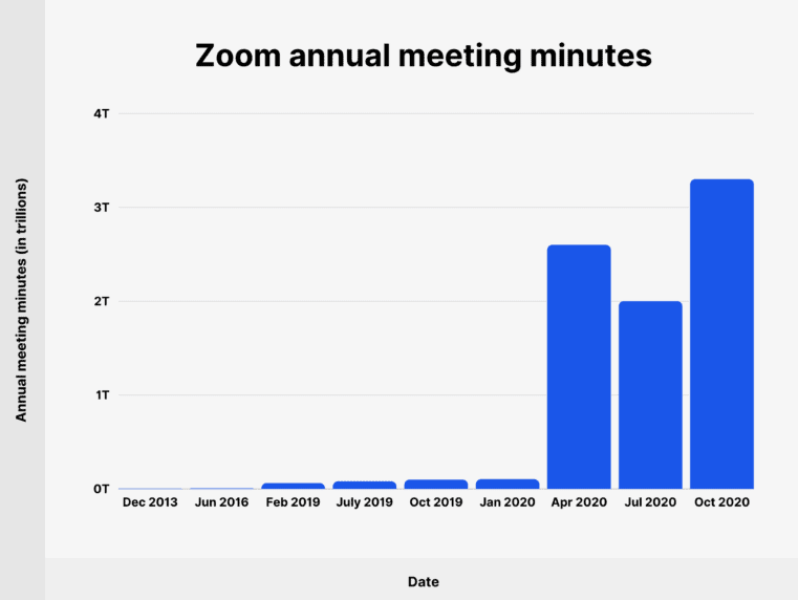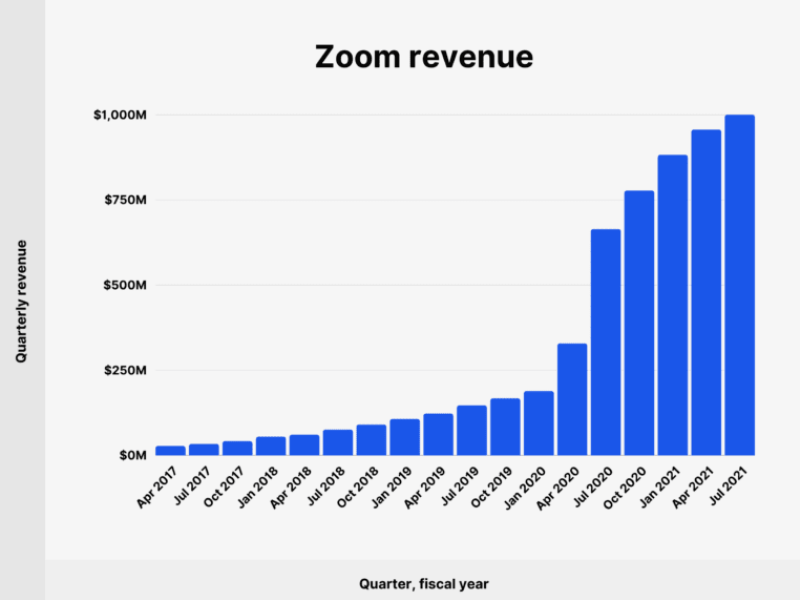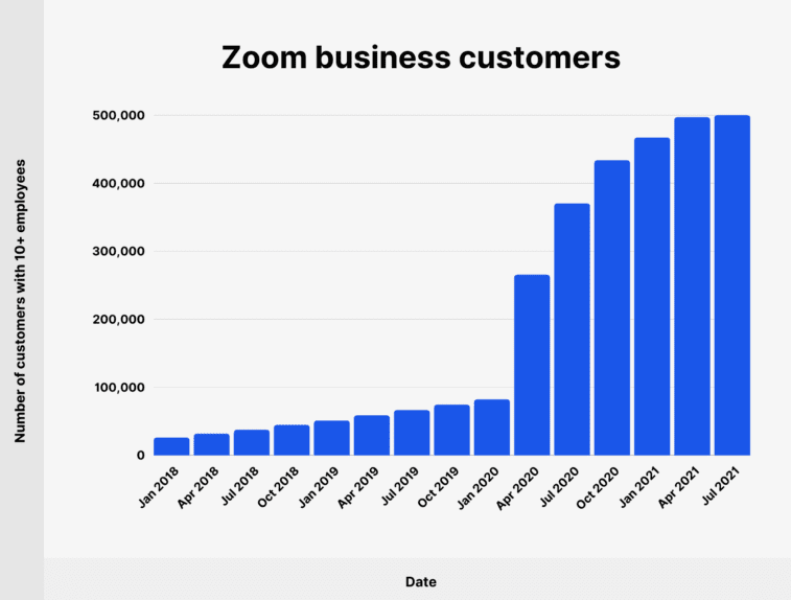Zoom Marketing Strategy: The Rise & Fall of Zoom Video Conferencing
Zoom emerged as a trend during the COVID-19 pandemic and has become the most-used video conferencing platform in the last two years. Zoom marketing strategy was such that it became the backbone of online education, office meetings, and even a handy method for staying in touch with family members.
The Zoom business model witnessed a massive spike in downloads worldwide. Did you know? Zoom even replaced a lot of entertainment apps like TikTok, WhatsApp and Instagram on the Google Play Store as a popular choice. In the western world, where there is a high demand for video conferencing, Zoom because of the king of the virtual workspace. It was so popular that “Zooming” was synonymous with video calling, like Googling something.
How did Zoom Marketing Strategy Get it to Where it is Today?
Founded by Eric Yuan in 2011 and launched in 2013, Zoom entered the public consciousness in 2020. It was because of Zoom that users all over the world turned to stay in touch during the lockdown. Yes, the pandemic was the primary reason for Zoom being a household name, but this was not a fluke. In 2016, Zoom’s marketing strategy made it the fastest-growing video conferencing app.
Since then, it has grown even faster. In 2018, Zoom saw an 876% growth in users. From March 2020, the Zoom business model saw the first installation explode by 728%. That’s when Zoom became popular. In fact, on March 23, 2020, the app was downloaded and installed 2.13 million times in a single day. This sort of success doesn’t happen overnight, even though many people might feel like it who hadn’t heard of Zoom before March 2020.
Also Read: Zepto Marketing Strategy – Everything About the 10-Minutes Grocery Delivery App
Zoom market research was smart, adaptive, and intelligent marketing strategies. That’s what made Zoom so much popular. Three key Zoom marketing strategies worked for them.
Crucial Aspects of Zoom Marketing Strategy
- Customer-Driven Design
- Freemium Model
- Radical Transparency
Through a collaboration of the above methods, Zoom market research capitalized on the opportunity to grow.
1. Customer-Driven Design
This is a classic company mantra. Every other start-up would say, “customer is everything,” but very few companies can live up to that. Before founding Zoom in 2011, Eric Yuan joined WebEx communications which quickly expanded and went public. Cisco acquired it in 2007.
While at Cisco, as a Corporate VP of Engineering, Eric was responsible for collaboration software development. Yuan started to observe a pattern of discontent in the meetings and conversations with the WebEx customers. They were not happy with the collaboration solutions at the time.
Even though Eric was looked after and paid handsomely, it didn’t matter in his eyes when he saw that the customers were unhappy with the product. After the management at Cisco didn’t respond, Eric left to set up Zoom meeting marketing strategies.
The only difference was that he was able to set up the company on the core values and Zoom marketing strategy that Eric desperately wanted for his audience. He created video conferencing software that not just worked but was also simple to use and could easily fit into your daily lives.
“We have a relentless focus on making the best product with the best user experience. This is ultimately what every customer wants. Toward this end, we spend much of our time listening to customers and fine-tuning our software to fit their needs.” – Eric Yuan, CEO, Zoom App.
Those at Zoom were only focused on the customer feedback, not just listening to them but also digesting it and acting on it until the perfect solution had been achieved that woes the customers.

2. Freemium Model
There is no denying that everyone likes to feel they are getting something for free. This is a universal truth. Freemium offers a quality product with some limitations. Zoom’s marketing strategy in 2022 involves a freemium model where the core features are free for everyone but only for 40 minutes if you want to meet more than 1 to 100 people. This offers a taste of greatness but also leaves you wanting more.
People wanted to jump into group meetings during the pandemic, whether through work or social. Also, they wanted the calls to last longer than 40 minutes, especially during the zoom drinking game socials. In a smart move, the Zoom meeting marketing team analysed the best time for a conference call and observed that it was 45 minutes. Reducing those 5 minutes was inconvenient enough for people who were wrapping up. This encouraged them to choose a valid subscription to the Zoom app.
According to Eric, “In our case, we want the customers to test our product. This market is extremely crowded. It’s hard to tell customers to try Zoom.” This plays well into Zoom’s core mission statement – making video communication frictionless. Zoom did that, but if you want truly unlimited features, you must pay. This is a smart move. The concept of frictionless doesn’t just apply to the user experience, but it is about the team, those who are working for Zoom.
3. Radical Transparency
It is not easy to find companies that offer complete transparency. You must expect that some of the figures will hide the CEO’s office doors or in the accounts. After all, if you leave everything on the table, you are leaving yourself open. This is one way to look at it, but Zoom’s competitive advantage is different. They offer complete transparency to offer trust and keep everyone informed.
If you visit the website, you shall find a lot of interviews with the core team, regular briefings, and blog posts on company direction. In addition, if you are a stakeholder, you can expect regular communication that is shared on all their social channels. Also, Zoom’s marketing strategy includes hosting Zoomtopia – an annual user conference.
Did the Zoom Marketing Strategy Work?
The figures speak for themselves. In 2013, throughout the year, 3 million people jumped on a Zoom meeting. By the end of 2015, 100 million people zoomed over the year. In 2020, More than 200 million people video-conferenced on Zoom every day.
The Fall of Zoom
The Zoom marketing strategies in 2022 made it the most preferred video conferencing app. However, significant concerns are being raised about the app’s security. There are reports that hackers were able to breach zoom video calls and tap into the webcam and microphone. In addition, researchers have found a security loophole that offers attackers access to windows passwords. Also, they noticed two flaws that can be used to access the user’s Mac and tap into the microphone and webcam.
Also, cyber risk assessment firms discovered that more than 500,000 Zoom accounts were sold on the dark web. In 2020, the Indian government declared Zoom an “unsafe Platform”, banning it for government use in a new advisory. However, it is not banned for the common people because it is not of Chinese origin.
Also, Taiwan and Germany have taken steps to discourage using Zoom. Similarly, in the USA, there were investigations on Zoom’s security practices, and the Federal Bureau of Investigation issued a warning about the hijacked sessions. In addition, Google banned using the platform’s desktop versions from the company laptops.
Even though Zoom’s marketing strategy in 2022 involved complete transparency, there were issues with the end-to-end encryptions. Zoom’s end-to-end encryptions were not entirely end-to-end. As a result, other Zoom meeting attendees could see a lot about you. The privacy policies of Zoom also offered the company the right to do whatever it wanted with the user’s personal data.
Thousands of Users Stopped Using Zoom
One of the main reasons why Zoom suffered an outage that affected thousands of users is the telephony feature faced downgraded performance. Therefore, it became difficult for the users to make calls using the Zoom phone. As a result, the Zoom marketing strategy that once ensured a seamless user experience proved unworthy of what it claimed.
Another significant reason so many people stopped using Zoom was the security flaw where the Zoom Client for Meetings and Zoom Rooms for Conference Room software failed to check the installation version in the update process. With Zoom’s server and client-server using different XML parsing libraries, a hacker could send a specific message to force the target client to download an older version of Zoom. This increased the chances of launching attacks using vulnerabilities.
The Zoom class-action lawsuit settlement was crucial in so many users leaving Zoom. As a result, if you have used Zoom between March 30, 2016, and July 30, 2021, you are entitled to a cash payout. How? If you are a Zoom subscriber, you are entitled to receive 15% of the total you paid to Zoom during the period mentioned above. If you are a free user, you shall get $15.
How Many People Use Zoom in 2022?
Yes, it is true that Zoom has lost many users due to security concerns and disturbed user experience in the last year. However, according to the reports of Zoom’s marketing strategy, it continues to be the most-preferred video conferencing app. In addition, there are a lot of stats that show Zoom is still one of the most popular video conferencing apps.
- In the 3rd quarter of 2021, the Zoom app hosted 3.3 trillion meeting minutes yearly.
- At present, the Zoom app has 504,900 customers.
- Every year, Zoom hosts 45 billion minutes of webinars
- This year, till now, Zoom generated $1.021 billion in revenue. This is an increase of nearly 54% from the last year.
- In December 2019, Zoom had 10 million daily meeting participants. Since then, they have grown 2900% on a day-to-day basis. At present, Zoom has 300 million daily active users in meetings.

Is Zoom Used Only for Work Purposes?
Zoom’s competitive advantage was its primary focus on the Zoom marketing strategy. It was to cater to businesses. Since the COVID-19 pandemic, many families have been separated and could not see each other like before. Therefore, Zoom attained a large user base of businesses and customers using Zoom to speak with family and friends. 64% of Zoom’s revenue is derived from customers with ten or more employees. Zoom disclosed that the number of paying customers with more than ten employees is a key metric in SEC filings.

Who Contributes to Most of Zoom’s Revenue?
Zoom offers a lot of plans and products that suit your needs. For example, the Zoom cloud meeting product range includes:
- Zoom meetings
- Zoom webinar & events
- The Zoom phone
- Zoom rooms
- Zoom united
Every product caters to the different needs of the diverse customer base developed in the last two years. Till now, Zoom meetings have been the most popular product for users that need a video communications app. Do you remember Skype? It is gradually becoming a thing of the past now. Zoom is the future of video communication.
The Zoom app users tend to be young. Half of the Zoom Cloud Meetings app users for iPad and iPhone are less than 35 years of age. Also, the Zoom marketplace has more than 1500 apps available for download. The number of available apps had increased by more than 650% since January 2020, when there were only 200 apps on the marketplace.

If you want to get all the details about the top features, pros, and cons of Zoom, you can check out this video.
https://www.youtube.com/watch?v=mZ_KuX8MfsM
Some Final Words
There is no denying the fact that the last two years have been a dream for Zoom in terms of profit and earnings. 2020 was the year when Zoom became popular. The zoom marketing strategy worked well, and they got lucky with the pandemic as the main reason for its growth. There were two impressive things that they did:
- They were able to handle all the growth
- They worked out their flaws and maintained the customer base.
The ability to scale rapidly is why they could hold on to so much of their revenue and usage growth. In addition, they have adapted well to the increasing user base. The best part is that even in the post-pandemic world, Zoom’s marketing strategy could hold on to the current user base.








